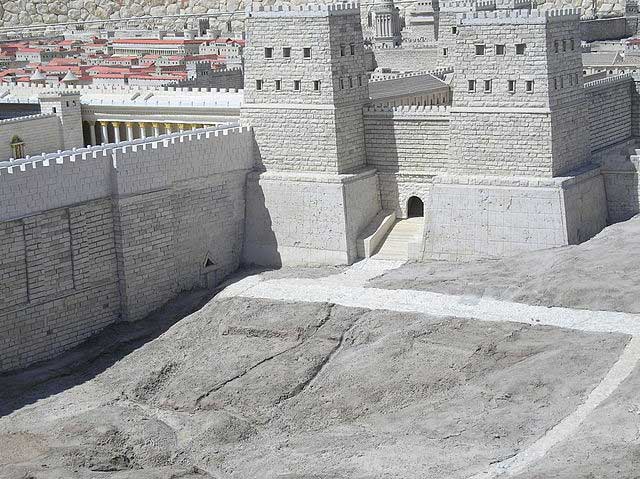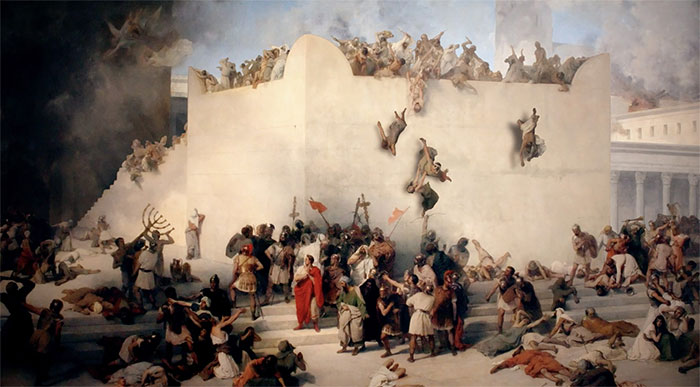The Jews lived for a long time under the yoke of the Roman Empire, until a revolt in 66 obliges the Roman emperor to send to Jerusalem the most seasoned legions.
In AD 64, Gessius Florus became governor of the Roman region of Judea (now Israel). Known to be hostile to the native population, Florus shows little interest in the religious life of the Jews.
When tax revenues fell sharply, Florus ordered the possessions of the Jewish temple in Jerusalem. This caused a wave of anger among the population.
The Holy Temple worships God, the supreme deity of the Jewish religion. The first sacred temple was built by King Solomon in 1000 BC, later destroyed by the Babylonians. The Second Temple, built in 516 BC, lasted until the Roman attack on Jerusalem in 70.
In 66, the Roman army entered Jerusalem, massacring 3,600 people. Florus’ actions sparked a Jewish uprising, also known as the First Judeo-Roman War.
The Jewish revolt
The revolt originated in Jerusalem. The people prevented the tribute from being moved to the temple to offer it to Caesar. In no time, the whole city of Jerusalem was in turmoil, expelling or killing Roman soldiers. The revolt spread throughout Judea.
In 67, Cestius Callus, the governor of neighboring Syria, brought 20,000 troops to Judea to quell the rebellion. After six months of siege of Jerusalem, Callus failed. 6,000 Roman soldiers died, including 5,300 infantry and 380 cavalry. Roman weapons were collected by the Jews for use in future defenses.
Nero, the 5th Emperor of Rome, sent Vespasian, a famous and very influential general at the time, to Judea to quell the rebellion.
Vespasian defeated the Jewish insurrection in Galilee (now northern Israel) and surrounding areas. The Roman army led by Vespasian besieged Jerusalem.

But before the siege, Vespasian received bad news from Rome. Emperor Nero died suddenly, Vespasian fell into a power struggle when the Roman armies of the eastern provinces all considered him emperor.
Vespasian was crowned emperor in 70, returning to Rome. He entrusted his son Titus with the pursuit of his conquest of Judea.
After 4 years of autonomy from the Romans, the Jewish community in Jerusalem did not define a specific strategic direction, even internal friction occurred, resulting in poor discipline of the army, no preparation for the battles to come.
The bloodiest siege in ancient history
Titus brought 70,000 Roman soldiers, including 4 warrior legions, began to besiege Jerusalem on April 14, 1970. It was also the time when many Jewish pilgrims from afar came to participate in the Passover.
At the time of the siege, Jerusalem was defended by nearly 40,000 well-equipped soldiers. The wall is extremely solid, divided into 3 layers, the last annular layer protecting the Holy Temple.
Titus applied the classic siege strategy of the time, which consisted of blocking all outside supplies.
As noted Jewish historian Josephus (37-100), Titus was extremely careful in formulating a siege strategy. The Roman legions were grouped in positions along the north and west walls, the soldiers in seven rows, the cavalry in three rows behind and the archers in the middle.
After about a month, waiting for the townspeople to fall into famine, Titus began to act. Titus brought to Jerusalem a siege weapon that the Jews had never seen before, a chariot dedicated to breaking the wall.
In 3 different locations, siege vehicles attacked simultaneously. The Jews fought bravely during the day, trying to fortify the increasingly weakened walls at night.
At one point, the city’s first wall collapsed, Titus and his elite army rushed inside.
“The Jews were forced to fall back on the defensive line behind the Second Wall. Titus continued to command the siege. In 5 days, the fighting has become fiercer than ever. The Jews fought as if they were ready to sacrifice themselves to defeat the enemy, ”writes historian Josephus.
The second siege was easier, and it took only five days for Titus to force the Jews to withdraw from the second wall.
Titus first ordered the Roman soldiers not to burn the houses, not to massacre civilians. But the Jewish warlords still wanted to fight, and they sought to overwhelm Romans everywhere.
After the next 3 days, the Jews were pushed to the last line of defense, defending the Holy Temple. Titus was in no hurry, putting his soldiers down, rechecking their armor and paying their soldiers in full.
“The situation at that time was very bad, there was famine everywhere. Many people have to eat their own species in order to survive. Those who snuck in in search of instant food were captured alive, tortured and crucified by Roman soldiers, ”writes historian Joephus.
In this bloody siege, Jephus was sent by Titus as a negotiating messenger, but the Jews refused to surrender.

After many unsuccessful attempts to break through the 3rd Wall, Titus switched to a night attack strategy. Fighting over part of the wall takes place night and day, but the Romans control part of the wall, gradually pushing back the Jewish defenses.
Having lost control of the 3rd Wall, all defensive efforts failed. Josephus reports that Titus wanted to preserve the Temple, but the soldiers were so angry with the stubbornness of the enemy that they burned the temple. On September 8, 1970, Jerusalem officially came under Roman control.
Josephus reports that over 1.1 million people were killed in the city’s bloodiest battle in ancient history. The Jewish historian explains the unusually high death toll among pilgrims who arrived in Jerusalem during Passover. Large numbers of pilgrims were trapped in the city and perished.
The rebels, the elderly and the sick were all murdered by Roman soldiers, with only 97,000 enslaved.
American historian Seth Schwartz said in 1984 that Josephus may have overestimated the death toll, as well as his biased accounts in favor of the Roman Empire.
After the fall of Jerusalem, Josephus followed the Roman army to Rome, becoming a Roman citizen. He spent the rest of his life chronicling the history of the Jewish people.


